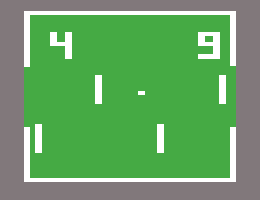Color TV-Game 15: Difference between revisions
BaconMastre (talk | contribs) (I added the Consoles category/template; after all, isn't this technically a console?) |
KirbyMelee (talk | contribs) (→As an Assist Trophy: it's funny when a character that gets hit by it flies so fast they just become an explosion on the upper blast line... at only 100%.) |
||
| Line 18: | Line 18: | ||
==In ''[[Super Smash Bros. 4]]''== | ==In ''[[Super Smash Bros. 4]]''== | ||
===As an [[Assist Trophy]]=== | ===As an [[Assist Trophy]]=== | ||
The Color TV-Game 15 made its ''Smash Bros.'' debut as an [[Assist Trophy]] in the fourth game of the series. Upon being summoned, two paddles from the game appear on-screen, playing a game of ''Pong'' by themselves, with the score appearing above each paddle. Not only does the ball that is bounced between the paddles harm players, the paddles themselves reflect projectiles for the opponents of the summoner and deal knockback to enemies that touch the paddles, while not inflicting any damage. | The Color TV-Game 15 made its ''Smash Bros.'' debut as an [[Assist Trophy]] in the fourth game of the series. Upon being summoned, two paddles from the game appear on-screen, playing a game of ''Pong'' by themselves, with the score appearing above each paddle. Not only does the ball that is bounced between the paddles harm players with extreme knockback, the paddles themselves reflect projectiles for the opponents of the summoner and deal knockback to enemies that touch the paddles, while not inflicting any damage. | ||
<gallery> | <gallery> | ||
Revision as of 22:18, July 13, 2016
| Color TV-Game 15 | |
|---|---|
 
Color TV-Game 15, as it appears in Color TV-Game 15. | |
| Universe | Color TV-Game |
| Debut | Color TV-Game 6 (1977) |
| Smash Bros. appearances | SSB4 |
| Most recent non-Smash appearance | WarioWare: Smooth Moves (cameo, 2006) |
| Console/platform of origin | Color TV-Game |
| Article on Wikipedia | Color TV Game |
The Color TV-Game 15 (テレビゲーム15, TV-Game 15) was one of the consoles of the Color TV-Game line, acting as one of Nintendo's first forays into the video game industry. Released in 1977, the console currently acts as the oldest entity in the Super Smash Bros. series, being three years older than Mr. Game & Watch and Pac-Man's debuts in 1980 and 2 years older than Sheriff.
In Super Smash Bros. 4
As an Assist Trophy
The Color TV-Game 15 made its Smash Bros. debut as an Assist Trophy in the fourth game of the series. Upon being summoned, two paddles from the game appear on-screen, playing a game of Pong by themselves, with the score appearing above each paddle. Not only does the ball that is bounced between the paddles harm players with extreme knockback, the paddles themselves reflect projectiles for the opponents of the summoner and deal knockback to enemies that touch the paddles, while not inflicting any damage.
In Super Smash Bros. for Wii U, from the Super Smash Bros. Direct.
Trophy information
The Color TV-Game 15 trophy appears in both versions. In Super Smash Bros. for Nintendo 3DS is a Challenge reward, obtained by playing 50 combined hours in the Smash mode. In Super Smash Bros. for Wii U it is part of the Memorabilia Trophy Box.
- Color TV-Game 15
Nintendo released this video-game console way back in 1977. You could play 15 different games, inspired by sports like tennis and hockey. In Smash Bros., paddles will appear on the left and right sides of the stage. You can hit the ball, but avoid touching the paddles at all cost!
In 1977, Nintendo released this home video game system in Japan with 15 variants of games like tennis and air hockey. In this game, the paddles appear at the sides of the stage, and a game of Tennis B starts. The ball can launch fighters on its own, but don't touch the paddles either!
- Color TV-Game 15 (Japan)
Origin
The Color TV-Game line of consoles was a series of consoles produced by Nintendo in the late 1970s, with all consoles only being released in Japan. The Color TV-Game series was among the numerous Pong clones produced after the production of Pong by Nolan Bushnell's Atari in 1972. The Color TV-Game 15 was the second iteration of the console, featuring fifteen game variants over the six offered by its predecessor. The paddles move in linear paths with the same consistent speed, in homage to how the original game was controlled by using microswitches.
| Nintendo consoles | |
|---|---|
| Home consoles | Color TV-Game 15 · Nintendo Entertainment System · Super Nintendo Entertainment System · Virtual Boy · Nintendo 64 · Nintendo GameCube · Wii · Wii U |
| Handheld consoles | Game & Watch · Game Boy · Game Boy Color · Game Boy Advance · Nintendo DS · Nintendo 3DS |
| Hybrid consoles | Nintendo Switch |




